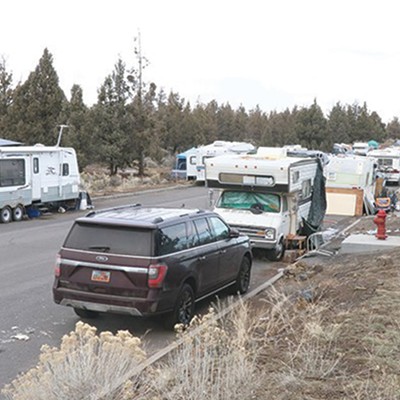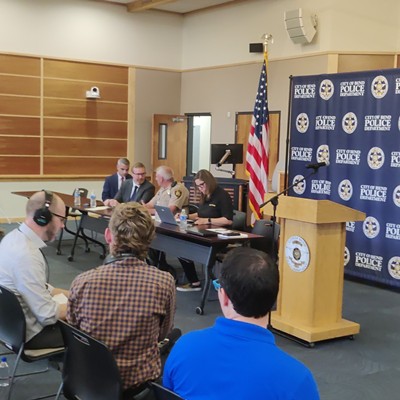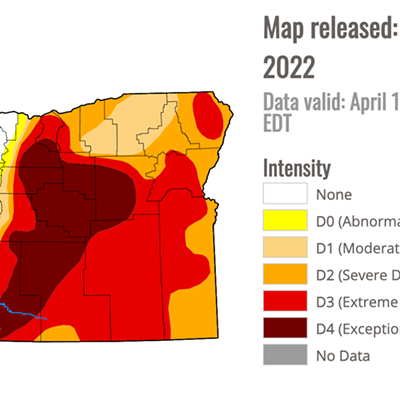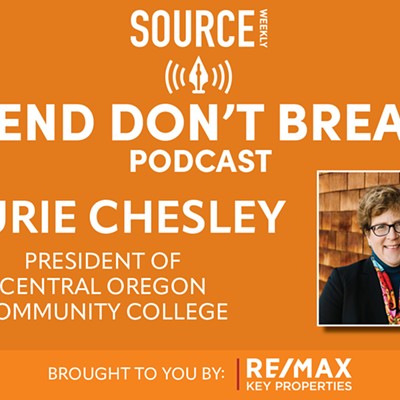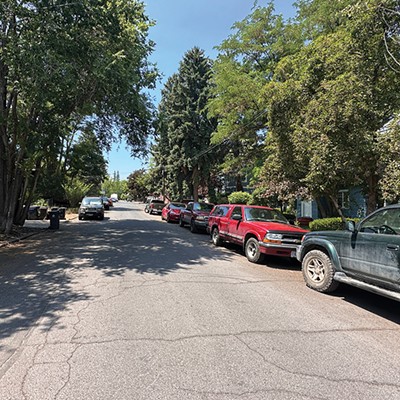Most days, Julie Kisic's neighborhood in Deschutes River Woods is a relatively quiet one. There are the sounds of commuting vehicles and chirping birds, but compared to the activity that could have been, that's pretty tame stuff.
Kisic is a homeowner living fewer than 50 yards from the volcanic flow at 19400 Comanche Circle, an 86-acre lava parcel that's become the center of a "Save the Lava" campaign. In June, Kevin Peterman, owner of the surface mining and gravel company, Able Supply, offered $185,000 for the parcel, with the intent to build a house on the land located below the lava.
The problem with that, DRW residents argued, was that the volume of material necessary to remove and grade the lava—sometimes as much as six stories tall—for a home build would significantly impact the neighborhood. And since the Deschutes County Property Information (DIAL) website assesses its value closer to $3,000, DRW residents also worried about the property value and the lack of clarity on county ordinances for maximum volumes allowed when clearing space.
Kisic says for the proposed space to be cleared, the neighborhood would have to deal with commercial dump trucks on streets intended for residential use, as well as blasting, crushing, and air quality pollution. For Kisic and other residents in the 5,451-person neighborhood, those concerns were just too much.
Kisic pointed out ordinances regarding surface mining wouldn't regulate this sort of grading because the material—lava—wasn't below the Earth's surface. Thus, establishing an ordinance stating maximum removal amounts was prudent.
The issue came up at a County Commission public comment meeting in early July. After DRW residents detailed their concerns, Peterman withdrew his offer to buy the land. Peterman has refused to comment for this story.
A History of Excavation—and Foiled Plans
Longtime DRW resident Tom Powell remembers when the Arnold Irrigation District acquired the property through a trade in 2004 and started excavating for a maintenance building the following year. Powell says that between neighbors complaining about the dust, rock and noise and a septic system failing to pass county requirements, AID eventually abandoned the project and built their facility on Buck Canyon Road.
Throughout the proceedings, Deschutes County Community Development Director Nick Lelack was careful to caution county commissioners to respond in a way that would "protect all parties." For the board to state anything in support or against on either side, Lelack explained, could be interpreted as prejudicial or bias in their quasi-judicial capacity. If prejudicial procedural error occurred, it could lead to a hearings officer making future decisions in proceedings, as opposed to the commissioners themselves.
Lelack also noted that crushing rock on site would be illegal without a permit from the county. If someone proposed site excavation in a manner never addressed before, the issue would be dubbed a "first impressions matter."
A first impressions matter requires a public hearing with an independent contractor to determine administering the Deschutes County code to the property. A decision is issued 30 to 45 days after the hearing, and then the decision could be appealed to the board of county commissioners—and later appealable to the state Land Use Board of Appeals, the Court of Appeals and the Supreme Court.
Barely Outside a Protected Boundary
Though Peterman withdrew his offer, patrons continue to worry that private ownership of 19400 Comanche Circle means development, permanently disfiguring a natural treasure, and endangered wildlife and the lava flow's ecological profile.
Visible on the horizon looking south from DRW or observable in map view, the Comanche Circle parcel is clearly contiguous with the flow draining from Lava Butte. The flow—with the exception of 19400 Comanche Circle—became the Newberry National Volcanic Monument 26 years ago, after two previous attempts in 1920 and 1940.
"Newberry Volcano is a special place," explains Daniele McKay, a geology instructor at the Oregon State University Cascades campus. "It is by far the largest volcano in the Oregon Cascades, and one of the most diverse in terms of the different types of volcanic activity that has occurred. Recent eruptions at Newberry have produced a wide range of volcanic features, which is part of the reason Newberry was designated as a national monument—to protect these special geologic features."
McKay says the Lava Butte lava flow is one of the youngest basalt flows at Newberry, making it an ideal location to study volcanic landscapes. "From a geologic perspective, it makes sense to protect the entire lava flow within the monument boundary. I was surprised when I heard this parcel wasn't already protected."
The Natural Resources and Sustainability Program Lead at OSU-Cascades, Matt Shinderman, PhD, weighed in by saying, "To be perfectly frank I don't know what to think about the proposition. In some ways I wince at the prospect of any development related to lava flows, but I also recognize that some development may not have measurable ecological impacts. It all depends on what and where."
According to Shinderman, critters including penstemon, rock spirea, the American pika and possibly bats have made a home in regional lava flows like the one adjacent to DRW. "We also tend to see a number of species that utilize habitats on the periphery, including wood rats, chipmunks, golden-mantled ground squirrels, lizards and the occasional bird." He notes these animals like the cool temperatures found in cracks and crevices below the surface, and the limited resources and terrain are likely to keep predators out.
Determining Value
At Deschutes River Woods, residents' most favored solution is to acquire 19400 Comanche Circle and incorporate it into the Newberry National Volcanic Monument. Mark Reinecke, AID's attorney, maintains that $185,000 would be an acceptable price, despite the value discrepancy with DIAL.
But assessed property value differences lead residents to believe AID aims to sell the parcel for development.
Reinecke responded by saying, "A professional appraisal was obtained from a local professional real estate company. The market value as of July 2016 was $185,000. It is our understanding that values have improved since July 2015. AID intends to sell the property, not for any particular use or purpose. That is a decision for the purchaser within the applicable county and state land use regulations. Also, the property is not zoned for commercial development. It is zoned residential, 10-acre minimum lot sizes."
Residents maintain that despite 19400 Comanche Circle's zoning, a grading loophole in county land use regulation remains.
Reinecke also noted AID's fiduciary obligations. The entity is under pressure with litigation expenses from third party lawsuits related to other conservation matters. While AID would rather put funds directly to maintenance and efficiency improvements, it's also burdened with improving the watershed.
Despite those other concerns though, Reinecke says the board has unanimously expressed a desire to work with the neighbors in DRW.
Conservation Clock Ticking
To pursue the conservation route, Kisic says residents have reached out to a significant number of local conservation groups, including Deschutes Land Trust, The Nature Conservancy, The Conservation Alliance, The Sierra Club, The High Desert Museum and others. So far, no group has agreed to take on the issue.
Even reaching out to Deschutes National Forest, the steward of Newberry National Volcanic Monument, wasn't fruitful, Kisic says.
Kevin Larkin, District Ranger, said in a letter: "...The Deschutes National Forest does not intend to pursue acquisition of this property at this time...The Arnold Irrigation District property does not meet...criteria. It would thus be a low priority for acquisition, and I concluded it would not be in the public's interest to expend taxpayer funds to pursue it further."
Naturally, that doesn't allay DRW residents' concerns.
"We don't know if a Peterman or a similar company will purchase this land for development before we can find a land conservation organization that will buy it. What we do know is that if a sale happens it will cost the neighborhood and the county a lot of time money and energy," said Bob Stillson, a DRW resident.
Whether AID is willing to continue to wait for the DRW residents to raise funds or conservation group interest, "Is up to AID's volunteer board of directors," says Reinecke. "Because AID is a quasi-public entity, decisions of this nature must be made by board member vote during a board meeting." AID's next board meeting is scheduled for Aug. 9. The board could consider this issue at that time or at future board meetings.
Kisic fervently explained, "I don't think it's the DRW that Bend remembers from the 70-80s. It's actually a very vibrant and up-and-coming community and we love how the lava weaves around our neighborhood. We were all so surprised when we found out the flow wasn't already entirely incorporated into the Monument."


